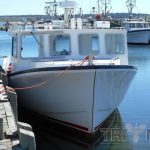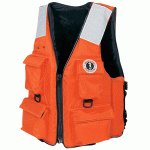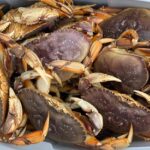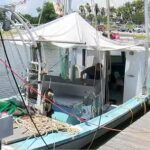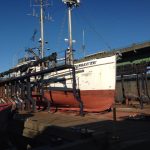Tag Archives: lobster bait
Maine lobstermen worried about cuts to how much herring they can catch for bait
 Fishermen in Maine say they’re dealing with a new setback: a nearly 90 percent cut in how much herring they can bring in to bait lobster. Congressman Jared Golden says he’s opposed to the limit, which would reduce the herring catch by 89 percent over three years. “What was troubling with this decision is there was no impact study done to us as fishermen, just an environmental study that was based on essentially one year of a proper study, to have implications to destroy an entire economic sector of Maine,” fisherman Ryan Raber said. Video, more, >>CLICK TO READ<< 06:19
Fishermen in Maine say they’re dealing with a new setback: a nearly 90 percent cut in how much herring they can bring in to bait lobster. Congressman Jared Golden says he’s opposed to the limit, which would reduce the herring catch by 89 percent over three years. “What was troubling with this decision is there was no impact study done to us as fishermen, just an environmental study that was based on essentially one year of a proper study, to have implications to destroy an entire economic sector of Maine,” fisherman Ryan Raber said. Video, more, >>CLICK TO READ<< 06:19
More alewives swim up the restored Bagaduce watershed
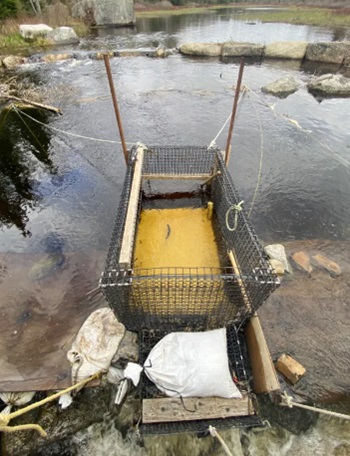 More than two years after the completion of multiple fish passage projects in western Hancock County, the effort appears to be paying off as alewives swim in greater numbers up the Bagaduce River watershed each spring. Those and other projects have contributed to a resurgence in the upstream migration of alewives, which are a key food supply for bigger wildlife, as well as a growing source of income for Maine fishermen who sell them as food or springtime lobster bait. From 2017 through 2021, the towns of Penobscot, Sedgwick and Brooksville worked with conservation groups to remove barriers that prevented fish from migrating between the tidal Bagaduce River and five ponds in its watershed. The idea was to help restore runs for fish, especially alewives, that travel upstream from Penobscot Bay and reproduce in the ponds more, >>CLICK TO READ<< 14:55
More than two years after the completion of multiple fish passage projects in western Hancock County, the effort appears to be paying off as alewives swim in greater numbers up the Bagaduce River watershed each spring. Those and other projects have contributed to a resurgence in the upstream migration of alewives, which are a key food supply for bigger wildlife, as well as a growing source of income for Maine fishermen who sell them as food or springtime lobster bait. From 2017 through 2021, the towns of Penobscot, Sedgwick and Brooksville worked with conservation groups to remove barriers that prevented fish from migrating between the tidal Bagaduce River and five ponds in its watershed. The idea was to help restore runs for fish, especially alewives, that travel upstream from Penobscot Bay and reproduce in the ponds more, >>CLICK TO READ<< 14:55
A personal-use mackerel fishery is coming, but P.E.I. fishers don’t know when
 Lobster fishers on P.E.I. say they’re happy to hear that a personal-use mackerel fishery will open this year, but they’re not sure it will help them with bait during the spring season. “If we got a chance to go get some, we certainly will,” said Allan Cody, who fishes out of Covehead. Mackerel is often used as bait in the lobster, halibut and other fisheries. Cody currently buys bait from a supplier in Tignish but it comes from waters near Iceland, he said. They’re frozen and then shipped to Canada. But “the fresher the mackerel the better.” photos, more, >>CLICK TO READ<< 08:02
Lobster fishers on P.E.I. say they’re happy to hear that a personal-use mackerel fishery will open this year, but they’re not sure it will help them with bait during the spring season. “If we got a chance to go get some, we certainly will,” said Allan Cody, who fishes out of Covehead. Mackerel is often used as bait in the lobster, halibut and other fisheries. Cody currently buys bait from a supplier in Tignish but it comes from waters near Iceland, he said. They’re frozen and then shipped to Canada. But “the fresher the mackerel the better.” photos, more, >>CLICK TO READ<< 08:02

Impact of bait closure heightens
The Atlantic spring herring fishery will not reopen this year, and while no decision has been made on mackerel yet, the stock remains deep in the critical zone. When the closure was announced in 2022, fishers already had bait stored up from the previous year. This year they expect to feel the full effects with the higher cost of sourcing alternatives. Allen Fay, a former bait fisherman out of North Lake who now fishes lobster, tuna and halibut, says the bait bill could double. It will be especially hard on younger fishers just getting into the industry who are already paying a lot for gear. Like many fishers, as well as the PEI Fishermen’s Association, he feels the closure doesn’t make sense because Americans will continue to fish the same mackerel stocks. >click to read< 11:53
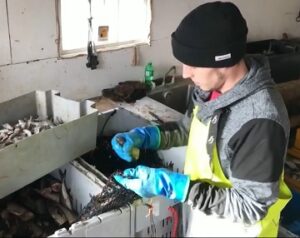
Fishers struggling to get lobsters to take the bait
Most fishers have their own bait recipe for what catches lobster. The season opened last week in Lobster Fishing Area (LFA) 33, which runs from Shelburne County, N.S., to Eastern Passage, and according to Brett Young, the lobsters have not been taking the bait. “We were doing a little better last year. I think the catches are down a little bit from last year,” said Young. Fishers in Eastern Passage have a few theories on why their catch might be down and one is because of post-tropical storm Fiona. Video, >click to read< 06:59
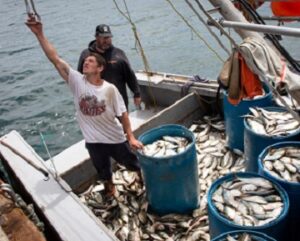
A key Maine lobster bait is booming. Soon fishermen may be able to catch more.
The Atlantic State Marine Fisheries Commission, an interstate regulatory body that oversees several species along the eastern seaboard, is considering new provisions that could increase catch quotas in Maine. Menhaden, commonly known as pogies, have become a top lobster bait as herring populations have declined. The proposal, which was released this week, includes several different allocation options and variations that would open up more fishing in Maine. Minimum allocations could be done on a tiered scale based on harvests going back to 2009. The commission could also shift the time frame that allocations are based upon to more recent years, which would give Maine a boost because of its increased landings. >click to read< 09:50
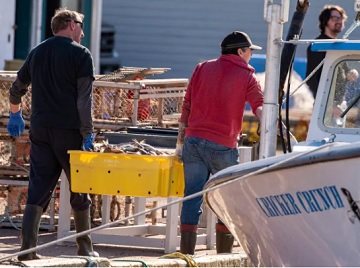
P.E.I. fishermen seek province’s help in wake of herring, mackerel moratorium
In March, the federal DFO put a moratorium on commercial fishing for herring in the Gulf of St. Lawrence and mackerel across the East Coast, saying urgent action is required to allow the stocks to recover. Fishers were not pleased, and said a complete moratorium goes too far. “This has been a devastating and direct blow for these fishers,” said Molly Aylward, the association’s executive director, appearing before a legislative standing committee on natural resources. The P.E.I.F.A. represents independent core fishers who depend on the commercial herring and mackerel fishery for their main source of income, as well as lobster fishers who use the fish for bait, often fishing it themselves to keep their costs down. >click to read< 09:17
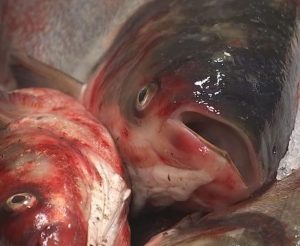
Ribbon Cut on Aurora Facility for Asian Carp Processing
New England faces a 70 million pound lobster bait shortage this year and the bait problem isn’t going away – neither are the invasive Asian Carp on Kentucky and Barkley Lakes. Brian Colgan founded Colgan Carp Solutions to provide a private sector answer to the Asian Carp problem. Their business models Asian Carp into a sought-after commodity with opportunities for entry into various markets. From bait to fertilizer, pet food and human consumption…there are numerous entry points for Asian Carp. To start, Colgan is turning Asian Carp into Lobster Bait. >click to read< 09:31
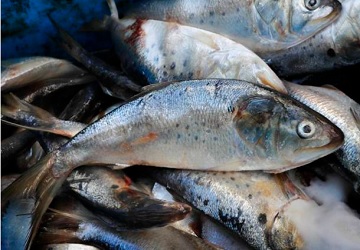
Surge in baitfish catch is a boon to Maine’s lobstermen
Maine’s lobster fishermen typically bait their traps with dead herring, but a scientific assessment in 2020 found that herring are overfished, and quotas for the fish were reduced dramatically. The loss of herring has increased the price of bait and made it harder for many fishermen to trap lobsters. However, losing herring has been offset somewhat by swelling catches of menhaden. Maine’s catch of menhaden, also called pogies or bunker, grew from about 6 million pounds in 2016 to more than 24 million pounds last year. >click to read< 11:28
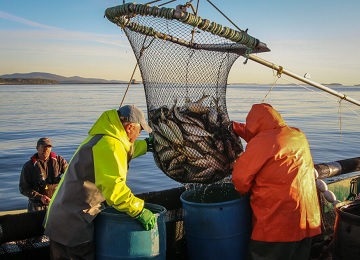
Pogies are back in Maine, and lobstermen say they’re more valuable than ever
Lobstering in Maine requires lots of bait, but Atlantic herring, a favored bait, are in short supply. Over the past few years, rebounding menhaden have been taking up the slack. Jamie Steeves, the lobster dealer who owns the boat the crew uses to catch the pogies, will sell the fish to lobstermen from the dock. “Let’s put it this way. If we weren’t catching pogies, and I say we as a whole, the industry, all my friends, those around us, if we weren’t catching them, this industry as lobstering would be in a lot of trouble,,, photos, video, >click to read< 16:53
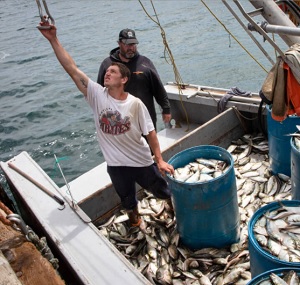
Maine: Pogie fishing season gets underway
Russell Libby turned to his crew at CBS Lobster and Bait on Union Wharf on Monday afternoon, telling them another boat was due in five minutes. Libby also told them it was close to sinking. That turned out to be an exaggeration but not by much. Before long, a small fishing boat came chugging around the corner. The Deja Vu II was so loaded with pogies, the open transom was several inches underwater. The crew was jubilant. “That’s the most I’ve had on there in 20 years,” said Capt. Dan Harriman of Cape Elizabeth. Dozens of plastic barrels stood stacked on the vessel’s deck. What little open space remained was awash in fish. The crew stood ankle-deep in them. Even the engine compartment was full of pogies.”We’ve got some down forward — we really do,” crewman Corey Doughty shouted up to the dockworkers. >click to read< , or here! 11:21
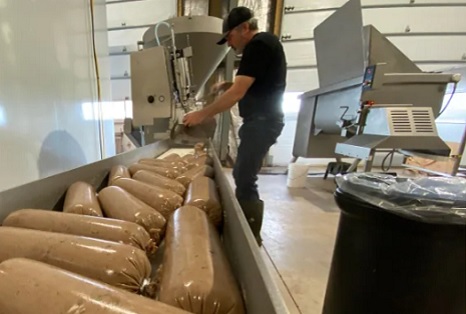
Bait Masters alternative bait got a bump in inquiries after mackerel quotas were cut in May
“We’re just two guys, so there’s going to be some logistics.” A P.E.I. company is getting ready to scale up production as word of its alternative bait spreads across North America, and a cut in the quota of traditional bait leaves fishermen looking for options. Bait Masters started producing their bait sausages in the $1.4 million facility in Nine Mile Creek, P.E.I.,,, Co-owners Mark Prevost and Wally MacPhee embarked on creating a new alternate 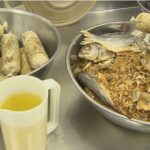 bait,,, In 2020, a UPEI researcher released his analysis based on field trials of the new bait in P.E.I. bays in the summer of 2019. It found that the new bait sausage created by Bait Masters catches as many lobster as traditional baits, such as herring and mackerel. >click to read< 07:55
bait,,, In 2020, a UPEI researcher released his analysis based on field trials of the new bait in P.E.I. bays in the summer of 2019. It found that the new bait sausage created by Bait Masters catches as many lobster as traditional baits, such as herring and mackerel. >click to read< 07:55
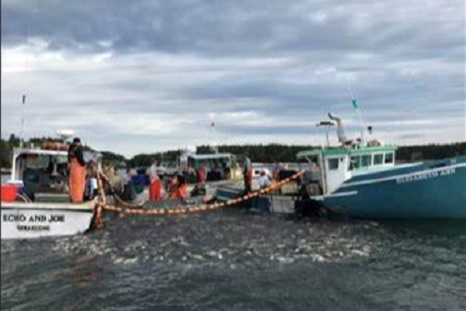
“Networks”: A rare, real look at the lives of lobstermen
“That funny looking water’s moving closer, Brooke,” Wallace says, motioning off in the nearby distance with his head as his hands work on the mooring. “That’s awful funny looking.” “Networks” is Mohnkern’s first film, and it tells a tightly focused story of a group of lobstermen from the Phippsburg village of West Point who hope to catch the shiny, surface-breaking fish known as pogies, or menhaden, causing all the ruckus in the water. It’s a story for the ages, men chasing fish and the consequences of their quest. But in just a few minutes, Mohnkern also manages to tell a story of a community of fishermen coming together for their common good and spotlights the economic impact of the migratory patterns of baitfish. >click to read< 09:32
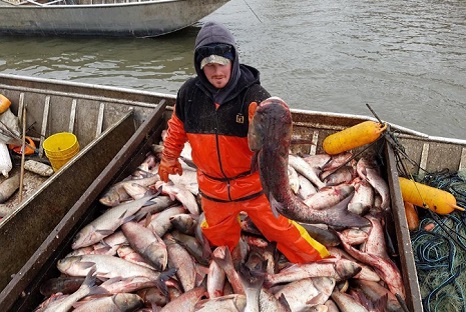
Asian carp processing facility might be headed to North Peoria
A former government adviser and official, Brian Colgan, leads a company that intends to convert a 4,000-square-foot building at 8606 N. Pioneer Road into an Asian carp processing, packaging and distribution facility. There the fish would be fashioned into bait for domestic crab, crawfish and lobster harvesters on all coasts. “Our company, Colgan Carp Solutions Inc., by creating these markets and working with others in the area who want to do the same, can drive up demand, can reduce the population in the Illinois River and hopefully create some jobs, economic opportunity and show that there’s a market-driven strategy for invasive-species management,” Colgan said. >click to read< 11:33
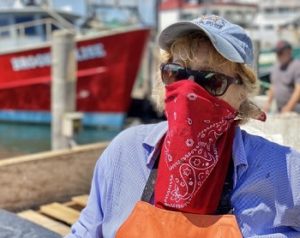
On the fishing docks of Point Judith: Sales are down, but they still work hard in the heat
She was surrounded by 450-pound barrels of the bottom fish, brought in by draggers. Despite wholesale lobster prices being down from the pandemic, boats are still going out to scratch out a paycheck. It’s all they have. Andrea was wearing orange oilers and rubber boots in the sun, driving a huge needle through four frisbee-size skates at a time to make a “string.” The bait not only lures lobsters but is good eating for them during the days they’re in traps before being hauled. Andrea joked that her skates are what makes lobsters taste good. I asked how old she is. She smiled and said, “None of your business,” then allowed she might be in her mid-60s. She’s a longtime fixture on the docks, having started “The Bait Company” there 36 years ago to serve the big boats that go out to sea. photos, >click to read< 22:15

Synthetic crustacean bait prepared for major evaluation in Nova Scotia
In early March 2020, Kepley BioSystems shipped several hundred synthetic crustacean baits for evaluation by a major lobster fishery in Canada under the leadership of industry experts, Clare Machine Works and Synergy Seafoods Limited. The effectiveness and palatability of the bait will also be studied in collaboration with the Université Sainte-Anne’s Marine Research Centre.,, This ecologically advanced approach would be made possible by a new formulation of OrganoBait™, an environmentally neutral blend of naturally occurring biochemicals found in wild fish baits and plant proteins that can attract lobsters and other crustaceans. >click to read< 10:53
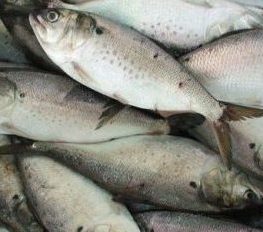
Maine DMR wants to close the pogy fishery to newcomers for 2 years while it crafts a new FMP/Enforcement plan.
“Closing fisheries is kind of a radical step and a dangerous step because it eliminates diversity,” said Commissioner Pat Keliher. “We’re not saying close it in perpetuity. Close it to see if there is a different approach here that would allow us to get both enforcement and reporting back under control.” Keliher said the 2019 menhaden season was challenging because of “a perfect storm of circumstances.” A sharp reduction in the herring quota spurred huge growth in the menhaden fleet, with 50 new boats rushing to satisfy the $485 million lobster industry’s need for substitute bait. >click to read< 07:23

Fishermen’s Alliance: Long-Waged Battle for Herring Won
The formal announcement from the National Oceanic and Atmospheric Administration reflected what much of the Cape wanted, a 12-nautical mile territorial sea boundary from the Canadian border to Connecticut and a 20-mile buffer off the peninsula’s backshore as well as catch limits based on the needs of the ecosystem. Supporters believe the buffer that keeps industrial-sized midwater trawl vessels from taking enormous amounts of herring out of local waters will go a long way towards rebuilding the entire inshore ecosystem and therefore boost the maritime economy. >click to read< 10:10

Bait and switch: Why this food scientist is taking lobster fishermen out for coffee
Zhuliang Tan grins broadly as he explains why he wants to meet with lobster fishermen from across Nova Scotia for conversations over coffee for science. The Dartmouth, Nova Scotia-based food research scientist was laid off during his company’s restructuring this past August, something he now enthusiastically embraces as a blessing in disguise. With numerous published peer-reviewed articles,,, >click to read< 12:48
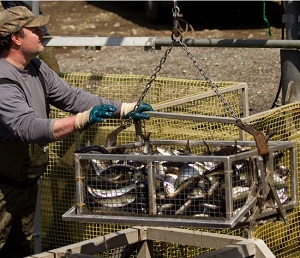
Survival of kiack fishery threatened, say Yarmouth County fishermen
A fishery that provides lobster fishermen with a favourite bait for their catch is struggling with a declining population. Gaspereau, also known as alewife and locally as kiack, swim up rivers in the spring to spawn in the still waters of lakes and return to sea in the fall. George Emin has been fishing kiack for 25 years, He blames Nova Scotia Power,,, Another huge issue impacting the kiack fishery is the massive influx of cormorant >click to read< 12:06

Maine gets another 4.7 million pounds of pogy, or menhaden, but will likely need more bait fish
The state ordered its menhaden fleet to stop fishing on June 30 after officials concluded it had exceeded the state’s annual quota of 2.4 million pounds by 1.5 million pounds, the majority of which was landed in the last four days of June, according to state records. But menhaden, a schooling forage fish also called pogy, were still abundant in Maine waters from Kittery to Penobscot Bay, so Maine sought access to another 4.7 million pounds of quota that is set aside for New England states to share when they catch their limit but the fish remains in large numbers. >click to read< 10:10
From DMR, MENHADEN: Daily Reporting Required for the Episodic Fishery – The menhaden fishery will resume under the episodic event set aside (EESA) program. The quota for the EESA is 1% of the 216,000 mt coastwide TAC, which equates to approximately 4.7 million pounds. DMR has implemented emergency regulation to open the Episodic fishery on Monday, July 15, 2019. >click to read<
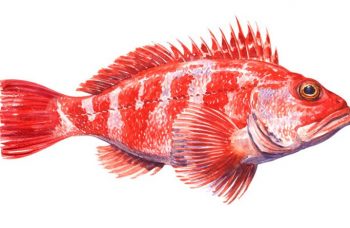
How the blackbelly rosefish from South America could help Maine lobstermen who are short on bait
The state for the first time has approved using fish raised off the coast of Uruguay as lobster bait to help offset a bait shortage that could increase lobster prices. Cook e Aquaculture USA of Machiasport announced the Maine Department of Marine Resources’ decision on Wednesday, saying it could help lobstermen weather a drop in the population of their primary bait source, herring, off the Maine coast. The New England Fishery Management Council in June cut the amount of herring fishermen can catch off the New England coast in 2020 and 2021. >click to read< 21:44
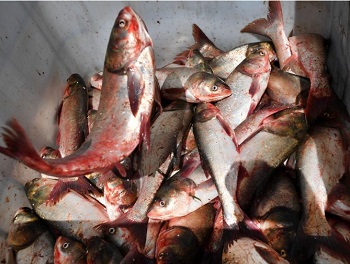
Luciano: Could Asian carp help a desperate Maine lobster market?
Officials in Illinois and Maine hope to soon announce a breakthrough that in both states could help solve aquatic challenges and boost economics. The news could especially bring a boon to central Illinois. In Illinois, invasive Asian carp choke the Illinois River. In Maine, the lobster industry faces a crisis for a sudden lack of lobster bait. If all goes well, commercial fishers in Illinois soon could be harvesting and shipping tons of Asian carp to Maine. >click to read<
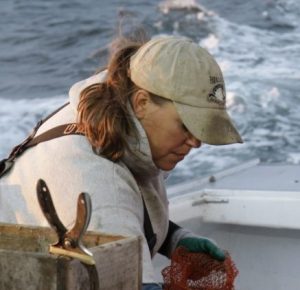
Maine is running out of lobster bait. Is salmon the answer?
Genevieve McDonald fishes out of Maine’s largest lobster port aboard the F/V Hello Darlings II. Last November, she became Maine’s first female commercial fisherman (“fisherman” and “lobsterman” are the strongly preferred terms for both women and men in the industry, she says) elected to the Maine House of Representatives, representing a district that includes Maine’s two biggest lobster ports. Not surprisingly, McDonald ran on a platform many in the fishing industry support. But above all else, one issue stood out. “Our biggest issue is the bait crisis,” she said in November,,, >click to read<11:51

This summer crisis could take the steam
This year federal authorities are imposing a steep reduction, and a few regions of the East Coast are restricted to fishing, months prior to the lobster season gets rolling. East Coast herring fishermen brought over 200 million pounds of these fish to docks lately as 2014, but the catch of this year will be limited to less than a fifth of that total. The cut scrambling for fresh lure sources, is leaving with herring for generations in Maine lobstermen, who have baited traps and concerned about their capacity to find lobster. >click to read< 12:40
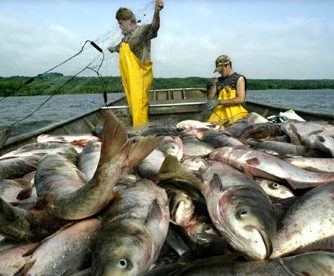
Canadian fishermen want cheaper lobster bait. Americans want to stop an invasive fish. And so, one man hatches a plan
Like whales breaching ocean swells, silver carp fly out from beneath the surface of waterways in Illinois. Tens of millions of dollars have been spent trying to keep the invasive fish – which procreate rapidly, crowding out other marine life – from spilling into the $7-billion Great Lakes fishery. And in an era of expeditious information-sharing, the “flying fish,” a form of Asian carp imported into the States decades ago, with hopes of using them to manage American ecosystems, have also caught the attention of gawking social-media spectators around the world. Three years ago, one of those spectators was a Nova Scotian named Patrick J. Swim. But instead of merely gawking, the self-described “lobsterpreneur” hatched a plan: >click to read<12:32

Large pogy catch good news for Maine lobstermen who feared bait shortage
All of the landings have yet to be counted, but officials say it is likely that an unusually large pogy fleet will have caught almost 7 million pounds of the fish, which is more than double last year’s landings. This comes as especially good news for Maine lobstermen, who use pogies to bait their traps when the herring supply runs low, as it is expected to this year. “Every pogy used was herring not used,” said Kristan Porter, a Cutler lobsterman and president of the Maine Lobstermen’s Association, which has been working with its members to prepare them for the herring shortage. >click to read<07:09
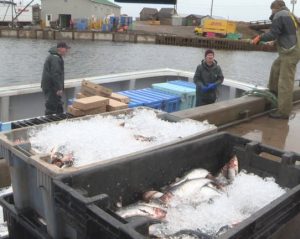
New Brunswick flooding leads to shortage of lobster bait on P.E.I.
The spring lobster season in P.E.I. hasn’t been open very long, but some lobster fishermen and buyers are concerned about the shortage of bait available to set their traps. One of the causes of the shortage this season is the flooding across New Brunswick, which is making it difficult for fisherman to get their boats in the water and catch gaspereau, a popular fish used as lobster bait in P.E.I. Jerry MacDonald, a buyer for Shediac Lobster Shop who works out of Naufrage Harbour in eastern P.E.I., said this season’s bait shortage is the worst he’s seen in years,,, >click to read<11:53
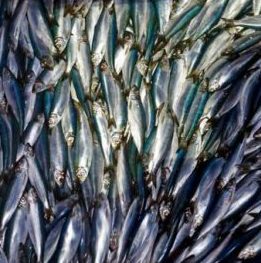
Drop in herring a mystery in Maine as bait price booms
Scientists and fishermen are trying to figure out why Maine’s Atlantic herring catch — the largest in the nation — has fallen from 103.5 million pounds in 2014 to 77.2 million last year. The per-pound price of the fish at the dock has gone up 56 percent since 2014, and that price is eventually borne by people who buy lobsters. “The whole dynamic of the fishery has changed,” said Jeff Kaelin, who works in government relations for Lund’s Fisheries, which lands herring in Maine. Kaelin, and others who work in and study the fishery, thinks climate and the way the government manages herring may have played a role in the decline of catch. Atlantic herring are managed via a quota system, and regulators have slashed the quota by more than 40 percent since the early 2000s. Last year, herring were also difficult to catch far offshore, where they are typically caught in large amounts, but they were abundant closer to the New England coast. This led to a bait shortage, because fishermen are only allowed to catch a certain percentage of their quotas in inshore waters. Read the story here 10:15
Study: Green crabs pose parasite threat as lobster bait
 Using the crabs as bait in the lobster fishery — which generated nearly $457 million in statewide revenue for fishermen in 2014 — has been considered as a possibility. Baiting lobster with green crabs might not be such a good idea, however, according to a study by a pair of Canadian scientists that was presented last month at a fisheries science conference in Dartmouth, Nova Scotia. Read the rest here 07:49
Using the crabs as bait in the lobster fishery — which generated nearly $457 million in statewide revenue for fishermen in 2014 — has been considered as a possibility. Baiting lobster with green crabs might not be such a good idea, however, according to a study by a pair of Canadian scientists that was presented last month at a fisheries science conference in Dartmouth, Nova Scotia. Read the rest here 07:49



































